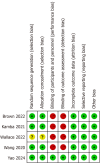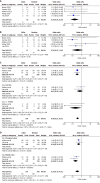Artificial intelligence for reducing missed detection of adenomas and polyps in colonoscopy: A systematic review and meta-analysis
- PMID: 40538513
- PMCID: PMC12175867
- DOI: 10.3748/wjg.v31.i21.105753
Artificial intelligence for reducing missed detection of adenomas and polyps in colonoscopy: A systematic review and meta-analysis
Abstract
Background: Colorectal cancer has a high incidence and mortality rate, and the effectiveness of routine colonoscopy largely depends on the endoscopist's expertise. In recent years, computer-aided detection (CADe) systems have been increasingly integrated into colonoscopy to improve detection accuracy. However, while most studies have focused on adenoma detection rate (ADR) as the primary outcome, the more sensitive adenoma miss rate (AMR) has been less frequently analyzed.
Aim: To evaluate the effectiveness of CADe in colonoscopy and assess the advantages of AMR over ADR.
Methods: A comprehensive literature search was conducted in PubMed, Embase, and the Cochrane Central Register of Controlled Trials using predefined search strategies to identify relevant studies published up to August 2, 2024. Statistical analyses were performed to compare outcomes between groups, and potential publication bias was assessed using funnel plots. The quality of the included studies was evaluated using the Cochrane Risk of Bias tool and the Grading of Recommendations, Assessment, Development, and Evaluation approach.
Results: Five studies comprising 1624 patients met the inclusion criteria. AMR was significantly lower in the CADe-assisted group than in the routine colonoscopy group (147/927, 15.9% vs 345/960, 35.9%; P < 0.01). However, CADe did not provide a significant advantage in detecting advanced adenomas or lesions measuring 6-9 mm or ≥ 10 mm. The polyp miss rate (PMR) was also lower in the CADe-assisted group [odds ratio (OR), 0.35; 95% confidence interval (CI): 0.23-0.52; P < 0.01]. While the overall ADR did not differ significantly between groups, the ADR during the first-pass examination was higher in the CADe-assisted group (OR, 1.37; 95%CI: 1.10-1.69; P = 0.004). The level of evidence for the included randomized controlled trials was graded as moderate.
Conclusion: CADe can significantly reduce AMR and PMR while improving ADR during initial detection, demonstrating its potential to enhance colonoscopy performance. These findings highlight the value of CADe in improving the detection of colorectal neoplasms, particularly small and histologically distinct adenomas.
Keywords: Artificial intelligence; Colonoscopy; Computer-aided detection; Neoplasms; Prevention and control.
©The Author(s) 2025. Published by Baishideng Publishing Group Inc. All rights reserved.
Conflict of interest statement
Conflict-of-interest statement: All the authors report no relevant conflicts of interest for this article.
Figures









Similar articles
-
Computer-aided detection versus advanced imaging for detection of colorectal neoplasia: a systematic review and network meta-analysis.Lancet Gastroenterol Hepatol. 2021 Oct;6(10):793-802. doi: 10.1016/S2468-1253(21)00215-6. Epub 2021 Aug 5. Lancet Gastroenterol Hepatol. 2021. PMID: 34363763
-
Real-Time Computer-Aided Detection of Colorectal Neoplasia During Colonoscopy : A Systematic Review and Meta-analysis.Ann Intern Med. 2023 Sep;176(9):1209-1220. doi: 10.7326/M22-3678. Epub 2023 Aug 29. Ann Intern Med. 2023. PMID: 37639719
-
Polyp detection with colonoscopy assisted by the GI Genius artificial intelligence endoscopy module compared with standard colonoscopy in routine colonoscopy practice (COLO-DETECT): a multicentre, open-label, parallel-arm, pragmatic randomised controlled trial.Lancet Gastroenterol Hepatol. 2024 Oct;9(10):911-923. doi: 10.1016/S2468-1253(24)00161-4. Epub 2024 Aug 14. Lancet Gastroenterol Hepatol. 2024. PMID: 39153491 Clinical Trial.
-
Impact of study design on adenoma detection in the evaluation of artificial intelligence-aided colonoscopy: a systematic review and meta-analysis.Gastrointest Endosc. 2024 May;99(5):676-687.e16. doi: 10.1016/j.gie.2024.01.021. Epub 2024 Jan 24. Gastrointest Endosc. 2024. PMID: 38272274
-
Effectiveness of artificial intelligence assisted colonoscopy on adenoma and polyp miss rate: A meta-analysis of tandem RCTs.Dig Liver Dis. 2025 Jan;57(1):169-175. doi: 10.1016/j.dld.2024.09.003. Epub 2024 Sep 24. Dig Liver Dis. 2025. PMID: 39322447
References
-
- Bray F, Ferlay J, Soerjomataram I, Siegel RL, Torre LA, Jemal A. Global cancer statistics 2018: GLOBOCAN estimates of incidence and mortality worldwide for 36 cancers in 185 countries. CA Cancer J Clin. 2018;68:394–424. - PubMed
-
- Mehta A, Kumar H, Yazji K, Wireko AA, Sivanandan Nagarajan J, Ghosh B, Nahas A, Morales Ojeda L, Anand A, Sharath M, Huang H, Garg T, Isik A. Effectiveness of artificial intelligence-assisted colonoscopy in early diagnosis of colorectal cancer: a systematic review. Int J Surg. 2023;109:946–952. - PMC - PubMed
-
- Kudo SE, Misawa M, Mori Y, Hotta K, Ohtsuka K, Ikematsu H, Saito Y, Takeda K, Nakamura H, Ichimasa K, Ishigaki T, Toyoshima N, Kudo T, Hayashi T, Wakamura K, Baba T, Ishida F, Inoue H, Itoh H, Oda M, Mori K. Artificial Intelligence-assisted System Improves Endoscopic Identification of Colorectal Neoplasms. Clin Gastroenterol Hepatol. 2020;18:1874–1881.e2. - PubMed
-
- Ahmad OF, González-Bueno Puyal J, Brandao P, Kader R, Abbasi F, Hussein M, Haidry RJ, Toth D, Mountney P, Seward E, Vega R, Stoyanov D, Lovat LB. Performance of artificial intelligence for detection of subtle and advanced colorectal neoplasia. Dig Endosc. 2022;34:862–869. - PubMed
Publication types
MeSH terms
LinkOut - more resources
Full Text Sources
Medical
Research Materials
Miscellaneous

